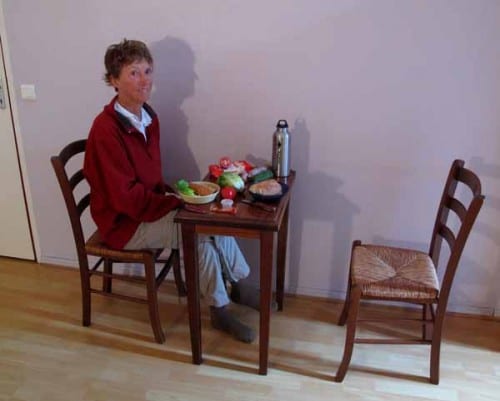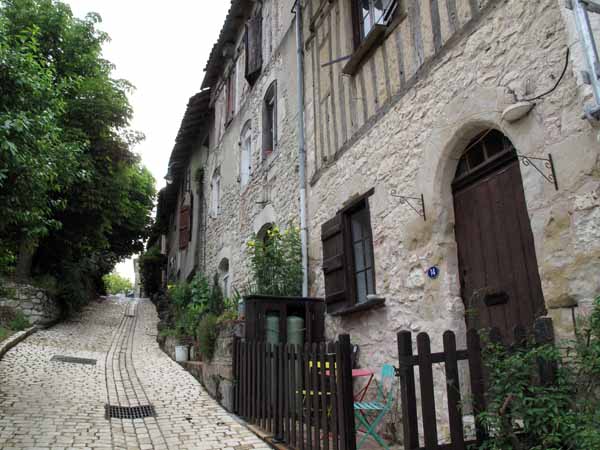Monday, 14 June 2010
Distance 17 km
Duration 3 hours 20 minutes
Ascent 203 m, descent 165 m
Map 56 of the TOP100 blue series (or Map 160 in the new lime-green series)
Topoguide (ref. 6542) Sentier vers Saint-Jacques-de-Compostelle via Vézelay

The icy showers outside had ceased but the hot ones in our room flowed copiously, a morning shower being a decadent luxury for us.
So was the hotel breakfast, which we took at a table next to the window in the dining room below.
The leafy garden was washed clean by the rain and full of birdsong as we tucked into orange juice, a pile of baguette slices, butter, jam and coffee, leaving nothing uneaten.

At 8 o’clock we left, with many thanks to our host, turned a corner and straight away found ourselves out on the highway, which swept up from the valley and around the ramparts.
After only a few hundred metres we came to a three-way fork and took the leftmost, smallest branch, the road to the delightfully named hamlets of Paris (three houses) and Petit Paris (two houses).

After that the GR crossed a stream and took off up a wooded ridge, but we suspected that the track would degenerate into a slimy bog, as so many others had this year, and preferred to stay on the road, which had the extra advantage of flatness.
Already we could see the broad stone bell-wall of the church at Pompiac and once past that, we soon arrived at another fine church, that of Valette, set apart from the village which was out of sight above the road. The facade of the church had an endearing likeness to a snowman, with eyes, nose and mouth surmounted by a little hat.
Here the road turned sharply right and we made our way across a wide valley full of wheat and young sunflowers. Grand old farm buildings squatted on the slopes amongst the crops, their tiny windows like moles’ eyes.


Passing one of these places as we climbed towards the ridge, we were suddenly bailed up by a large angry dog, hackles up and teeth bared, making dashes at our ankles.
A woman’s nasal Cockney voice called “‘E won’t bite, ‘e’s ‘armless!”, but Keith has no patience with irresponsible owners who do not train their animals, and she received a short, colourful summary of his opinion, reducing her to an offended “Well! What language!”
Apart from the nuisance of the dog, it was a bit depressing to realise that the modern invasion of the English had reached even these parts, when we had imagined ourselves in “La France Profonde”.

However we soon forgot about it as we topped the rise and descended to Lougratte on the highway, where we hoped for coffee.
To our disgust, the whole place seemed to be in the process of being dug up for some unknown purpose. Traffic was creeping between barricades and there was no sign of a bar, even though we trudged up and down the wreckage of the main street.
We set off grimly to rejoin the GR, but heavy clouds were swarming overhead, and when we saw a sign saying “Cancon 5”, we decided to put our heads down and make a final push along the highway to our destination.
It only took an hour and as highway-bashes go, it was not too bad. The road was lined with prune orchards in various stages of maturity, from weedy seedlings to full-sized trees. There was a long rise before we reached the town and we were able to leave the highway and take a steep old road into the main street.
We picked up some pastries at a boulangerie, and at the first hotel that we came to, the Hotel des Voyageurs, we slumped into chairs under an awning and called for the coffee that we had been deprived of in Lougratte. It was already lunch time but we did not care. The joy of arrival and the delicious coffee restored us in body and spirit equally.

Eventually we walked on another block and found the Office of Tourism. The camping ground would open tomorrow, we were told, and this was no surprise, as the traditional day for municipal camping grounds to open is the 15th of June, all over France.
There was another hotel, les Glycines, at the far end of the town, and internet access at the library. Les Glycines was new and smart, with rooms for €50. We went back to the old Hotel des Voyageurs and got a room for €35, not as flash but right in the centre.
After showers, we ate our lunch from a bedside table and then settled down to sleep, only rising at 4 pm to go to the library. When we emerged after checking our emails, the low clouds finally burst and we had to sprint back, ducking from one awning to the next in our slippery sandals, and thanking our lucky stars that the camping ground had not been open.

Back in the room, we read a brochure that we had picked up in the Office of Tourism, describing a walk through the old town.
We realised that the part of town that we had seen so far was only a latter-day addition to what had been a well-fortified village higher up, and when the rain stopped, we went exploring.
This village had grown up at the foot of the original eleventh-century hilltop château, which had controlled a section of the Roman road from Agen to Périgueux (the same Roman road that we had been following off and on ever since Saint-Astier).
In the thirteenth century the village was established, laid out in a typical bastide plan.

Of the château, only a fragment of the donjon remains, the rest having been destroyed in the revolution, but the old village with its square, its steep, cobbled lanes and its half-timbered houses is well maintained.
All, that is, except for one house, whose entire back wall had recently crumbled onto the houses below one night, giving the occupants an unexpected (and unwelcome) view of the lower town.

As it was Monday night, the dining room in the hotel was closed, but we were fed because we were residents. There was only one other guest and the three of us were ushered into the empty room for a set menu of crudities, then crumbed cutlets, then Café Liégeois.
With an apéritif of rosé and a jug of red with our food, it was very satisfying. Being able to go to bed by merely climbing the stairs instead of going out into the blustery night was a bonus.
Previous day: Bergerac to Castillonnès